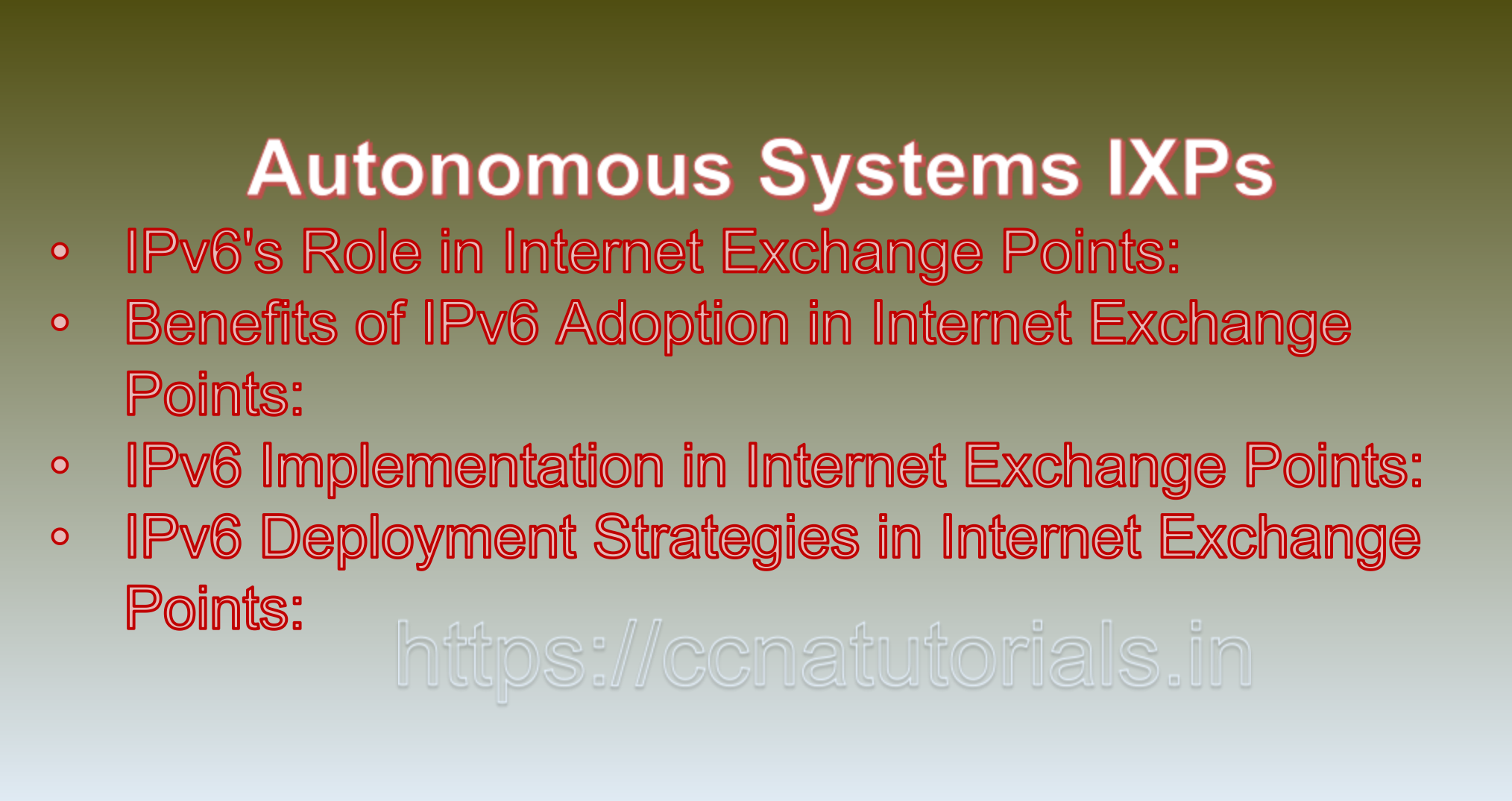Contents of this article
In this article, I describe IPv6 and Internet Exchange Points Advancing Global Interconnectivity. Internet Exchange Points (IXPs) play a pivotal role in the infrastructure of the internet by facilitating the exchange of internet traffic between different networks and service providers. As the digital landscape evolves and the number of connected devices surges, the limitations of the current addressing scheme, Internet Protocol version 4 (IPv4), have become evident. Internet Protocol version 6 (IPv6) offers a solution to address these limitations, aligning with the mission of IXPs to enhance global interconnectivity. This article explores the integration of IPv6 within IXPs, highlighting its significance, benefits, and considerations.
1. IPv6’s Role in Internet Exchange Points:
– Address Space Expansion:
IPv6’s expansive address space is essential for accommodating the multitude of networks, devices, and services that connect through IXPs.
– Efficient Routing:
IPv6’s optimized header structure enhances routing efficiency, resulting in reduced latency and improved network performance for data-intensive applications.
– Enhanced Interconnectivity:
IPv6’s scalability ensures that IXPs can support the growing number of networks and devices seeking to interconnect and exchange traffic.
2. Benefits of IPv6 Adoption in Internet Exchange Points:
– Scalability:
IPv6’s extensive address space enables IXPs to accommodate the increasing number of networks and devices participating in traffic exchange.
– Simplified Network Management:
IPv6’s autoconfiguration capabilities streamline the process of assigning unique IP addresses to devices within IXPs, reducing administrative overhead.
– Global Interconnectivity:
IPv6 ensures that IXPs can continue to serve as critical hubs for global interconnectivity by providing the addressing resources needed to facilitate traffic exchange.
3. IPv6 Implementation in Internet Exchange Points:
– Dual-Stack Deployment:
– Solution: IXPs can implement dual-stack networks that support both IPv4 and IPv6 simultaneously.
– Outcome: This approach ensures that devices connecting to IXPs can use either IPv4 or IPv6 addresses, allowing for a gradual transition.
– IPv6-Only Deployment:
– Solution: IXPs can opt for IPv6-only networks, particularly for new deployments or expansions.
– Outcome: An IPv6-only deployment simplifies network management and aligns with the trajectory of IPv6 adoption in the broader internet ecosystem.
4. IPv6 Deployment Strategies in Internet Exchange Points:
– Traffic Exchange Enhancement:
– Scenario: An IXP operates as a key point of connectivity for various networks and content providers, facing challenges related to address exhaustion and network congestion.
– Solution: The IXP adopts IPv6 through dual-stack deployment, allowing participating networks to exchange traffic using either IPv4 or IPv6 addresses.
Outcome:
– Networks connected to the IXP experience improved traffic exchange efficiency, reducing congestion and latency.
– The IXP accommodates new networks seeking to participate in traffic exchange, ensuring its continued role as a vital connectivity hub.
– New IXP Deployment:
– Scenario: A region lacking adequate internet connectivity plans to establish a new IXP to improve local interconnectivity.
– Solution: The new IXP is designed as an IPv6-only deployment, aligning with the latest networking standards.
Outcome:
– The new IXP embraces the future of networking by focusing on IPv6 adoption from its inception.
– The IXP becomes a catalyst for local interconnectivity and digital growth, attracting networks, content providers, and businesses seeking efficient traffic exchange.
5. IPv6 Challenges and Considerations in Internet Exchange Points:
– Member Readiness:
Ensuring that networks connecting to an IXP are IPv6-ready is essential for facilitating seamless traffic exchange.
– Transition Mechanisms:
Implementing transition mechanisms, such as NAT64/DNS64, to facilitate communication between IPv6 and IPv4 networks is crucial during the transition phase.
– Network Security:
Enhancing network security measures to accommodate the features and potential vulnerabilities of IPv6 is vital for maintaining the integrity of traffic exchange.
6. IPv6 Success Stories in Internet Exchange Points:
– Global IXP Expansion:
– Scenario: A prominent global IXP experiences increased demand for its services as more networks seek efficient traffic exchange.
Outcome:
– The IXP adopts IPv6 through dual-stack deployment, providing participating networks with the flexibility to use both IPv4 and IPv6 addresses.
– Participating networks benefit from reduced latency and enhanced traffic exchange efficiency, contributing to the IXP’s reputation as a premier interconnectivity hub.
– Emerging Market Connectivity:
– Scenario: An IXP in an emerging market seeks to bolster local internet connectivity and encourage digital growth.
Outcome:
– The IXP deploys an IPv6-only network to align with the latest networking standards and ensure efficient traffic exchange.
– Local networks and content providers experience enhanced interconnectivity, driving economic development and technological advancement.

In short IPv6 and Internet Exchange Points: Pioneering Global Interconnectivity with IPv6 and IXPs:
The integration of IPv6 within Internet Exchange Points (IXPs) is vital for advancing global interconnectivity and ensuring seamless traffic exchange across networks and regions. As IXPs continue to play a crucial role in the internet ecosystem, adopting IPv6 addresses the limitations of IPv4 and positions IXPs for a future where network growth and digital innovation are paramount. By implementing IPv6 through strategies like dual-stack or IPv6-only deployments, IXPs can continue to serve as pivotal hubs for traffic exchange, fostering collaboration and efficient communication among diverse networks and stakeholders. IPv6 empowers IXPs to lead the way in shaping a connected and scalable internet landscape for the years to come.
IPv6 and Internet Exchange Points (IXPs): Enabling Efficient Global Data Exchange
Internet Exchange Points (IXPs) play a critical role in the architecture of the internet by facilitating the exchange of data traffic between different networks and Autonomous Systems (ASes). As the internet continues to expand and evolve, the limitations of the current addressing scheme, Internet Protocol version 4 (IPv4), have become evident, especially within IXPs. Internet Protocol version 6 (IPv6) offers a solution to address these limitations and align with the evolving landscape of IXPs. This article delves into the integration of IPv6 within IXPs, highlighting its significance, benefits, and implementation considerations.
1. IPv6’s Role in Internet Exchange Points (IXPs):
– Address Space Expansion:
IPv6’s extensive address space is essential for accommodating the multitude of networks, devices, and services interconnected within IXPs.
– Efficient Traffic Exchange:
IPv6’s hierarchical addressing structure enhances the efficiency of traffic exchange at IXPs, resulting in improved routing and reduced latency.
– Simplified Network Management:
IPv6’s autoconfiguration capabilities streamline the process of assigning unique IP addresses to devices connected to IXPs, reducing administrative overhead.
2. Benefits of IPv6 Adoption in Internet Exchange Points (IXPs):
– Scalability:
IPv6’s vast address space ensures that IXPs can accommodate an increasing number of networks and devices, supporting the growth of internet traffic.
– Enhanced Routing Efficiency:
IPv6’s optimized header structure contributes to efficient routing within IXPs, resulting in improved network performance and lower overhead.
– Seamless Interconnection:
IPv6 enables seamless data exchange between networks and ASes connected to IXPs, fostering an interconnected and collaborative internet ecosystem.
3. IPv6 Implementation in Internet Exchange Points (IXPs):
– Dual-Stack Deployment:
– Solution: IXPs can implement dual-stack networking, which supports both IPv4 and IPv6 protocols simultaneously.
– Outcome: Dual-stack IXPs allow participating networks to exchange data using both IPv4 and IPv6 addresses, ensuring compatibility during the transition phase.
– IPv6-Only Deployment:
– Solution: IXPs that are being established or modernized can opt for IPv6-only deployments to align with the evolving networking landscape.
– Outcome: An IPv6-only IXP streamlines network management and reflects the trajectory of networking technologies, optimizing performance and resource allocation.
4. IPv6 Deployment Strategies in Internet Exchange Points (IXPs):
– Network Modernization:
– Scenario: An IXP operating for several years faces challenges in accommodating the growing number of networks and devices due to IPv4 address limitations.
– Solution: The IXP implements IPv6 through dual-stack deployment, allowing connected networks to exchange data using both IPv4 and IPv6 addresses.
Outcome:
– The IXP ensures seamless interconnection between networks, regardless of their addressing protocols.
– IPv6’s extensive address space supports the IXP’s growth plans, facilitating efficient data exchange between participating ASes.
– Greenfield Deployment:
– Scenario: A new IXP is being established to cater to the networking needs of a specific region or industry.
– Solution: The IXP chooses to adopt IPv6-only deployment, leveraging IPv6’s scalability and efficient routing for seamless data exchange.
Outcome:
– The new IXP optimizes network resources by efficiently assigning IPv6 addresses to connected networks and devices.
– IPv6’s streamlined routing enhances the IXP’s performance, positioning it as a cutting-edge hub for data exchange.
5. IPv6 Challenges and Considerations in Internet Exchange Points (IXPs):
– Compatibility:
Ensuring that the devices and networks connected to IXPs are IPv6-compatible is essential for smooth data exchange and network operation.
– Transition Mechanisms:
Implementing transition mechanisms, such as NAT64/DNS64 or 6to4, to facilitate communication between IPv6 and IPv4 devices is crucial during the transition phase.
– Collaboration:
Cooperation between IXPs, network operators, and content providers is necessary to ensure a coordinated and successful integration of IPv6.
6. IPv6 Success Stories in Internet Exchange Points (IXPs):
– Established IXP Expansion:
– Scenario: An established IXP experiences increased demand for its services due to the growing number of networks seeking interconnection.
Outcome:
– The IXP adopts IPv6 through dual-stack deployment, accommodating networks that use both IPv4 and IPv6 addresses.
– Participating networks benefit from improved routing efficiency and seamless data exchange, promoting collaboration and innovation.
– Next-Generation IXP:
– Scenario: A new IXP is being launched in a region with a strong focus on embracing advanced networking technologies.
Outcome:
– The IXP implements IPv6-only deployment, reflecting its commitment to modern networking practices.
– Networks connected to the IXP experience optimized data exchange and routing efficiency, attracting networks seeking state-of-the-art interconnection services.
Conclusion for IPv6 and Internet Exchange Points Navigating the Future of Data Exchange with IPv6 in IXPs:
The integration of IPv6 within IXPs is essential for fostering efficient data exchange, accommodating the growing number of networks, and supporting the evolving demands of internet connectivity. By implementing IPv6 strategies such as dual-stack or IPv6-only deployments, IXPs can overcome IPv4 limitations and position themselves as hubs for seamless interconnection. IPv6 empowers IXPs to thrive in a data-driven world, facilitating collaboration, innovation, and improved network performance. As the internet ecosystem evolves, the adoption of IPv6 within IXPs paves the way for a more interconnected and efficient internet landscape.






